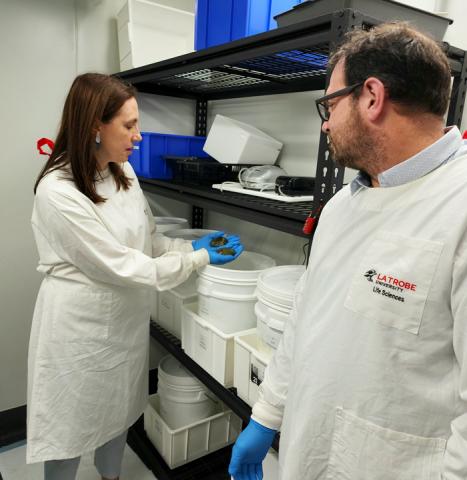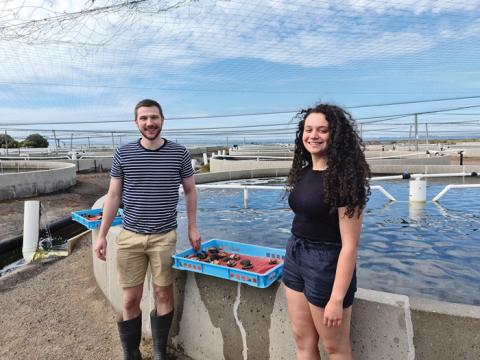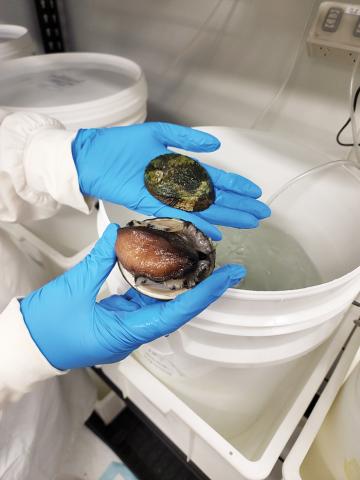World-first research to transfer immunity against a deadly abalone virus through the generations is underway
By Melissa Marino
A balone viral ganglioneuritis (AVG) is a killer and an ongoing threat to wild abalone (Haliotidae) populations. In 2005, it infected two of Australia’s abalone farms, wiping out stock that then took three years to rebuild.
After lying dormant for some years, an outbreak of AVG was detected among wild abalone along the Victorian coastline in May 2021.
“Our farm and the Yumbah [Aquaculture] facility at Narrawong near Portland both got destroyed by the virus in 2005,” says Mark Gervis, General Manager at Southern Ocean Mariculture at Port Fairy. “We lost everything. And unfortunately, the virus is back out in the wild now.”
Yumbah Chief Executive David Wood shares Mark’s concern. “The ocean water is the vector that the virus comes through. And given that it’s done so in the past, we certainly treat it as a real threat and risk within our business. If it gets onto the farm, it’s a major concern, potentially causing significant biological and economic loss,” David says.
AVG is related to the herpes virus and is endemic in the Southern Ocean water that is pumped into aquaculture farms on the Victorian and South Australian coast. The outbreak in May 2021 prompted a swift response from the wild and farmed sectors. At their request, the Victorian State Government enacted a biosecurity plan, including establishing exclusion zones to minimise spread.
The virus was contained, but such mitigation measures are a short-term fix. Similar to the herpes virus that causes cold sores in humans, AVG tends to reappear when abalone are under stress.
Without in-built defences, the threat of another outbreak is an ever-present concern for the high-value, high-risk abalone sector. “With good populations of wild abalone off the coast, there’s a potential threat the whole time,” Mark says. “For us and for Yumbah, we are pretty much in the firing line with the disease, so we’re pretty desperate for a solution.”
Game changer
Karla Helbig, an Associate Professor at La Trobe University, is leading new research and working closely with sector partners to build immunity against AVG in abalone populations. It is the first time such a project has been undertaken on abalone. And it could be the game changer that the sector is seeking.
The four-year project kicked off in 2021 with funding from FRDC and the Australian Abalone Growers Association (AAGA). It involves Southern Ocean Mariculture, Yumbah Aquaculture and Jade Tiger Abalone as sector partners, with trial sites at Port Fairy, Narrawong near Portland and Indented Head on the Bellarine Peninsula, respectively.
David says AVG is a major concern for abalone farming and the wild-caught sector. “If there’s a way that we can prevent it through immune programs, then that would be a fantastic breakthrough,” he says.
For Karla, the aim is to offer abalone producers a strategy to protect their stock against wipe-out from AVG. “That’s the goal. And we think we’ve got a very good shot of getting there.”
Vaccinating invertebrates against viruses has always been a challenge, says Karla, who is a virologist and innate immunologist. Her previous work has largely focused on humans, and, to a lesser degree, oysters.
Unlike people, but similar to insects and oysters, abalone do not have a specific immune system and cannot make antibodies to protect themselves against a particular virus.
In humans, those antibodies provide protection against the virus should a person be reinfected. “And that’s how a vaccine works,” Karla explains. “In [humans or other vertebrates (animals with a backbone)], you try to trigger an immune response by delivering a harmless replica of the virus or its components. And then your body will remember that it’s seen that particular virus and it can protect itself when it sees it again.”
Without the capacity to generate these specific virus-fighting antibodies, vaccination strategies used in humans and other vertebrates cannot be applied to invertebrates such as abalone.
But Karla and her team have shown that, in the laboratory, an immune response can be triggered in abalone through what is known as immune priming.


Associate Professor Karla Helbig and Professor Travis Beddoe will challenge primed abalone in the laboratory at La Trobe University with the virus and monitor the response. Photo: Karla Helbig
“It’s been shown that if you immune prime some animals just before they procreate, they can have a heightened level of immunity against pathogens.” Karla Helbig
Priming for protection
Immune priming replicates a naturally occurring mechanism in some insects. Priming stimulates the immune system through the injection of a synthetic non-viral nucleic acid, which causes a non-specific, or innate, immune response that protects the animal from the virus.
Although effective, this approach is not practical in a real-world context because it requires injecting each abalone to trigger the immune response. “It’s not that useful for a farm because they have millions of abalone and you can’t inject all of them,” Karla notes.
The researchers are investigating whether injected abalone broodstock will pass the same immunity onto their progeny. This technique, known as transgenerational immune priming, has been demonstrated in insects and oysters, she says.
“It’s been shown that if you immune prime some animals just before they procreate, they can have a heightened level of immunity against pathogens,” she says.


PhD student Jacinta Agius and Masters student Angus Watson work closely with the farms to develop immune-priming strategies against AVG infection. Photo: Karla Helbig
The ‘D’ in R&D
Her research is testing whether transgenerational immune priming is effective in abalone and how long protection in progeny will last.
To achieve this, the researchers are working hand-in-hand with sector partners.
“We’re taking our in-lab experiments to the farms and injecting their brood stock, and then we’re going to follow the babies, to see if they are afforded protection,” she says. “So it’s a really good collaborative project.”
In addition to his role at Southern Ocean Mariculture, Mark is also Chair of the AAGA. He says the project’s design will ensure that abalone producers will be equipped with the skills and knowledge to apply the research and vaccinate their stock on-site.
“This is really your ‘D’ part of R&D. Getting on-farm experience as the research progresses will make it much easier to apply,” he says. “And if it’s successful, we will be looking to use it as a stock standard methodology on our farm.”


Australian hybrid abalone are housed in aquariums within constant temperature rooms at La Trobe University for use during the trials. Photo: Karla Helbig
Tangible impact
With the involvement of three producers, who also advised on the project and trial design, the research can cover more bases and be protected against risk.
“The beauty about having multiple farms involved is that spawning can be a bit of a hit-and-miss operation, and so by spreading it across the farms, it’s likely that we will have success. If we get failures on any single farm, there should be back-up from another,” Mark says.
It also ensures the project will have a broad scope. Three different abalone species (Greenlip [Haliotis laevigata], Blacklip [Haliotis rubra rubra] and a hybrid) will be tested, and each farm will prime abalone at different times to determine when it is most effective.
“We can cover off more experiments,” Mark says. “For example, we want to know the optimum time for priming abalone before you spawn them. So, our farm will prime a month out from spawning. Another farm is doing two months out. And we’re also priming a couple of days before spawning. It increases the power of the project.”
The researchers and producers are also keenly watching to see whether increased disease resistance corresponds with poorer abalone growth – an outcome that has been observed in some fish species.
The farms will keep a proportion of primed animals on-farm to monitor their growth outcomes in a real-world setting against a control group of animals. “And because every farm has different temperatures and environments, it will give us a much clearer understanding of whether any impediment is across the board or related to something more specific,” Mark says.
To test for disease resistance and whether it wanes over time, Karla will take primed abalone progeny at various growth stages from the farms to her biosecure laboratory at La Trobe University. “We will challenge them with the virus to see whether they can protect themselves,” she says. “And we’ll keep doing that every few months and track their response.”
New frontiers
On-farm abalone priming is already underway and Karla expects to have an understanding of its efficacy later in 2022.
Further efficiencies and improvements will also be investigated. In the project’s second phase, Karla is working with La Trobe University protein chemist Professor Travis Beddoe on new ways to trigger the immune-priming response in abalone without injections.
“We’re investigating the development of a synthetic product that might be ingested, or the animal might be immersed in it to protect them against viral infection,” she says. “And that’s quite a new concept.
“If abalone could be primed for an immune response en masse through a feed or water source, without relying on intergenerational transfer, it could help protect them more quickly from a specific AVG threat, such as the 2021 outbreak,” she says.
For David, the collaborative nature of the project is significant. “It’s a terrific display of industry cooperation, and we are fortunate that we’ve got scientists of the calibre of Karla and her team taking the lead on a project like this. Both in our industry and more broadly in aquaculture, the research arm is extremely important.”
Transferring immunity from treated broodstock to juveniles to prevent disease would be a cost-effective solution long sought by the sector to mitigate its biggest risk, says David. “Not only would it be a significant breakthrough in terms of risk management for the farms, but it would be done in a highly efficient manner.”
David says business confidence would be markedly boosted if it had virus-resistant stock as its first line of defence against the devastating AVG disease. “If the project delivers the outcomes we hope, it will be extremely significant. It doesn’t mean we would drop or reduce our biosecurity awareness, but it would mean a lot of our farmers would undoubtedly sleep better at night.”
Karla says working with the sector to achieve a tangible impact is proving to be an incredibly satisfying part of the project. “As a scientist, that’s what we all live for – to be able to do something that changes the game for somebody else,” she says.
Workshops and guidelines will be developed to help ensure the project’s findings can be adopted on-farm. f
More information
Karla Helbig - k.helbig@latrobe.edu.au





